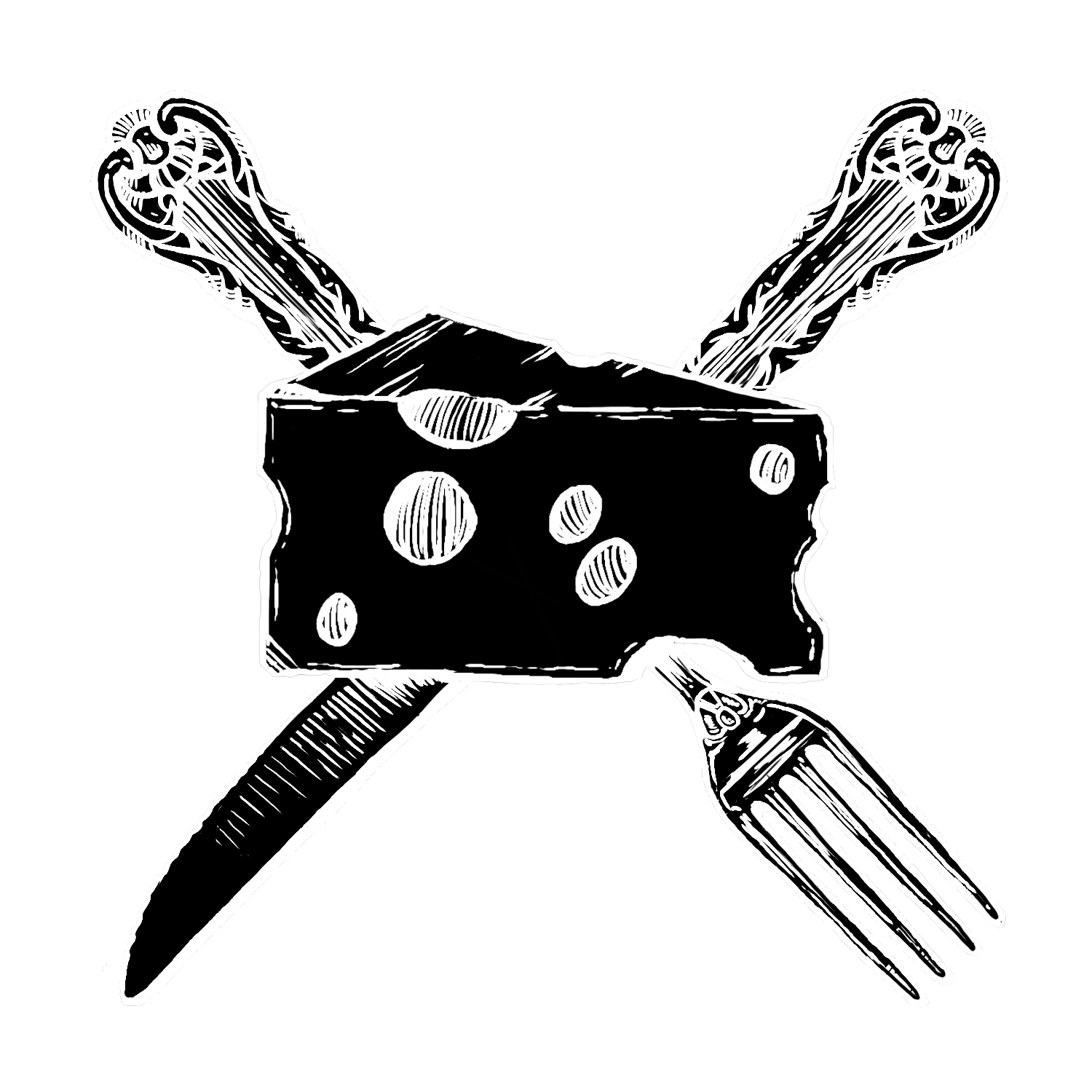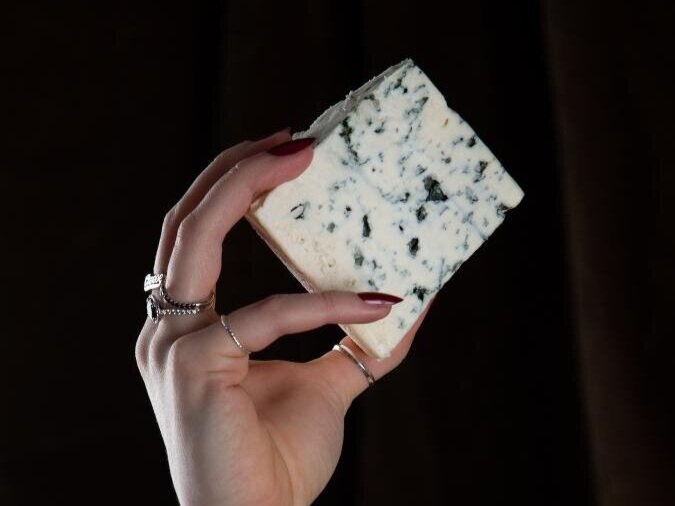Do You Need to Throw that Moldy Cheese Wedge Away?
Moldy cheese has been a sensitive topic for me since last summer, when I published a video that went viral for all the wrong reasons: it was a simple demo featuring my hands scraping and slicing the mold off of a block of cheddar that I’d neglected in my cheese drawer for a few weeks too long. It was mottled with soft white and green patches, which I carefully removed before shredding the cheese and nestling it onto a tuna melt. I had no idea the video would be controversial, and was more worried that people would be grossed out by my tuna salad recipe (some people seem to really hate mayo, and I used a lot of it).
The video soon amassed millions of views and thousands of comments, mostly accusing me of endangering people’s lives. A couple microbiologists even stitched my video into their own TikTok describing how dangerous my mold scraping process supposedly was. The whole situation caused me to second guess what I had learned in my cheese career about food safety. I thought my mold scraping was standard procedure and one that I had been taught when I first started working in cheese almost 10 years ago. I was scared that maybe I had put people in danger, and I worried about stoking the fires of fear that already plagued the cheese industry, especially after those same microbiologists started coming after raw milk (another topic for another day).
After gathering myself, I sat down with my friends at Jasper Hill Farm, one of the most famous creameries in America, to discuss the food safety concerns with scraping rogue mold off of old cheese. They are not only trailblazers in our industry, but they meticulously test every batch of cheese for pathogens to ensure that each product is safe, delicious, and ready for consumption. They also have a very knowledgeable team, including microbiologist Julie Pringle and cheese evaluator, educator, and my buddy from the monger days, Alex Armstrong, both of whom helped me craft this response.
Harbison from Jasper Hill Farm
Here’s what I learned about finding mold on your cheese and how to handle it, according to the cheese microbiologist at Jasper Hill Farm.
Cheese is mold, especially artisan cheeses. Cheese contains a mystical yet highly studied ecosystem that’s intentionally inoculated with molds and other microbes. All of this helps, and is often essential, to create a transcendently tasty cheese. For example, on a soft cheese, such as Jasper’s superstar Harbison (pictured above), the molds on the rind penetrate into the cheese and work to digest the inner paste, slowly transforming it into a mesmerizing silky, oozy texture. While you can only see the molds on the rind, they’ve already worked their magic on the inner paste too. Obviously, that’s the work of intentional mold, but those were once rogue molds until scientists isolated and commercialized them for cheesemaking. They went through all that trial and error so we don’t have to.
Cheesemaking microbes are friends, not foe. Scientists have studied cheese microbes for centuries, and through trial and error they have discovered how to adjust the moisture levels, acidity, and salt content to reduce the risk of harmful microbes in favor of those that are beneficial or neutral. If a rogue mold starts populating a firm cheese, it’s likely that it was present in the ripening space or making up the rind’s flora and is now growing onto the cut surface. If commonly found surface molds were a risk to public health, then cheese businesses would have to eliminate those risks. After all of that careful testing and procedures, rogue molds carry more risk of affecting the flavor and texture than making you sick.
The mold growth on firm cheese is not contaminating the whole cheese. Like all fungi, mold has mycellia, a root-like network made up of branching threads called hyphae. This interweaving system often lives within organic matter, such as soil, vegetative matter, or even cheese. The roots can easily penetrate porous, moisture-rich material like raspberries or fresh cheeses like mozzarella, but the hyphae can’t travel that deep in a dense product like cheddar cheese.
Firm cheeses are dense, so it would take months for the hypha to fully infiltrate the entire body of cheese. However, molds can easily penetrate porous, moisture-rich substances like fresh cheeses, such as fresh mozzarella, so you should throw those away if they get moldy. Those cheeses are high moisture and not meant to age, so mold indicates spoilage. Soft-ripened cheeses, such as brie-styles, are also higher moisture and have a shorter lifespan than firm cheeses, making them more susceptible to unintentional molds without the same defenses against pathogens. Finding unwanted molds on those guys are definitely an indication that the cheese has passed its prime and should be tossed.
Eating mold is not dangerous by nature. Some molds are toxic, but those strains are rather rare when you look at microbial diversity as a whole. This is going to be really creepy to some people, but mold is literally everywhere. In fact, we eat it everyday whether we know it or not because, I repeat, it’s everywhere! There’s mold on our skin, floating in the air, and working its way into all of our food, whether or not you can see it. It’s unavoidable, and most of it isn't going to hurt you. There's no way of knowing what kind of mold it is, but because of the precautions that cheesemakers undergo, it is unlikely to be harmful.
No, eating mold will not ruin your gut flora. We’re ingesting mold traces whenever we eat, drink, and breathe. Mold is a wonderful and healthy part of our daily lives that you can’t avoid mold or sanitize out of your life. In fact, your gut microbiome is filled with microorganisms, and the more the better! If there’s enough beneficial bacteria, it can even protect you against harmful intruders. Of course, there are harmful molds you don’t want, and you should be cautious when you see a rogue mold that’s not supposed to be there, but how cautious you are is up to you.
If you do get sick from a cheese, it’s more likely due to a well-known pathogen rather than some mystery mold. The main pathogens that affect cheese are very well documented. They are invisible to the naked eye, and include Listeria Monocytongenes, E. coli O157:H7, Staph Aureus, and Salmonella. Cheesemakers work very hard and undergo rigorous testing to prevent these pathogens, and are required to screen and monitor their cheeses for them, usually with the help of a third party lab. In the very rare event that you get sick from a cheese, it’s more likely due to one of these pathogens than a rogue mold.
If you do cut off the mold, eat the remaining wedge ASAP. Cheese always tastes best when it’s freshly sliced from the wheel, and rogue molds mean that wedge has been sitting around for too long. The USDA recommends cutting off an inch on the affected surface. Personally, I just scrape it off, or slice off about ¼”. I’m aware that it doesn’t remove the mold entirely, but I’m OK with that. For me, the bigger issue is with the deteriorating flavors and textures in the wedge indicated by the mold growth. That cheese is probably past its prime, so it needs to be eaten ASAP while it’s still tasting good.
In conclusion, there’s no perfect answer to whether or not that moldy cheese is dangerous, but it might be helpful to know that the experts are more concerned about the sensory experience of that moldy cheese than they are about whether or not it will get you sick. “If there was a likelihood that our products turn to poison once removed from their packaging,” says Jasper Hill, “we'd probably be extremely anxious about hurting people and going bankrupt. Instead, we're snacking on moldy cheese right alongside you.”
The truth is that mold is everywhere, and there is always going to be some risk when there’s visible mold on a cheese. But, in the realm of food safety, there’s also a lot of risk when it comes to eating melons or berries or sprouts. Just look at the FDA reports. If you see unintentional mold on your cheese, cut it off. If you have underlying health conditions, are immunocompromised, or just risk averse, throw the cheese away. Trust your judgment, and do what’s best for you no matter what anyone on TikTok or Instagram tells you. And that includes me! Everyone has their own comfort level, so you have to do what’s right for you.
What to do if you find mold on your cheese:
Ask yourself when you bought the cheese and if the mold is a continuation of the rind or otherwise belongs.
If you bought the cheese weeks ago, and the mold seems foreign to the cheese, then consider cutting off up to an inch around the affected area.
If you’re really worried about it, just throw it away.
If it’s a soft cheese, then throw it away. That mold might not be dangerous, but the cheese is definitely past its prime.
How to avoid getting mold on your cheese:
Eat that cheese within a week of buying it: cheese stops ripening and begins to deteriorate as soon as it’s cut, so it’s best to buy only as much as you need for the week, eat it fast, and then buy more.
Use cheese paper to properly store your cheese: plastic wrap cuts off oxygen and traps moisture, which accelerates decomposition. Read more about proper cheese storage here.
Wash your hands and your knife before and after cutting cheese. I’d also recommend doing the same if you’re cutting multiple types of cheeses, to avoid cross-contaminating microbes.
Citations:
Acknowledgements:
Thank you to Julia Pringle and Alex Armstrong at Jasper Hill for your support and expertise on this article! Thank you also to Emilia d’Albero for being my right hand man during this debacle. Also shout out to my whole cheese fam for being very supportive during this. Love you all!


